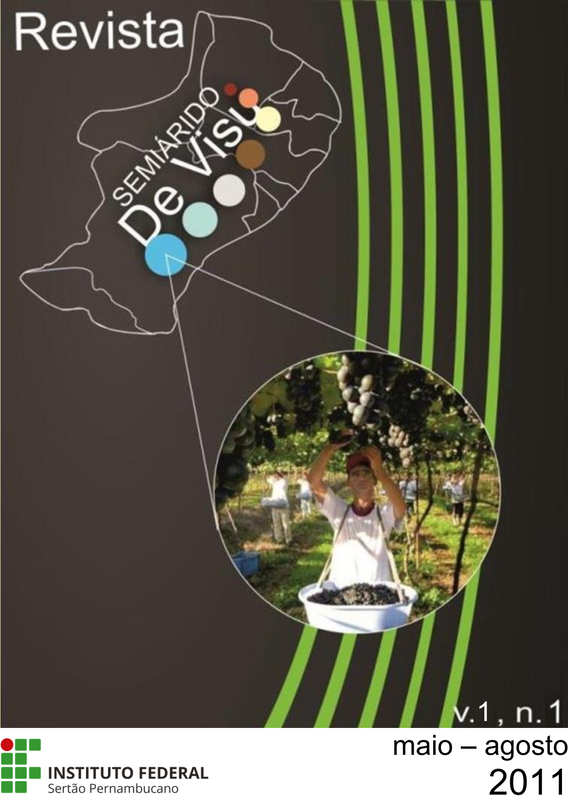Influence of organic composition in the physicochemical characteristics of the “Brasília” carrot in the city of Petrolina (PE)
Visualizações: 443DOI:
https://doi.org/10.31416/rsdv.v1i1.204Keywords:
vegetable, postharvest, nutritional qualityAbstract
This study was developed with the objective of evaluating the effect of the organic composition in the cultivation of “Brasília” carrots and its influence in the postharvest phase of this vegetable. Experiments were driven in a community vegetable garden in traditional cultivation system (irrigated), located in the city of Petrolina – PE. The formulation of the organic compound was made with 40% of tanned goat manure and 60% of residues of vegetable
remains. The rootses were picked 92 days after sowing, later, they were taken to the postharvest laboratory for analyses. The two treatments for the cultivation of the carrot were assessed, starting from the harvesting phase, in order to
examine the influence of the organic compound in the product, through the analyses of humidity, total soluble solids (TSS), total tritable acidity (TTA), TSS/TTA relation, carotenoids and pulp firmness. The statistical analysis demonstrated that there was a significant difference among the main physicochemical characteristics of the carrot at the level of 5% among the several analysis, indicating that the use of the organic compound in the cultivation of the carrot is a promising tool in the maintenance of its quality and nutritional value for the postharvest phase.
References
AOAC. ASSOCIATION OF OFFICIAL ANALYTICAL CHEMISTS. Official Methods of Analysis of AOAC international. 16 ed. Maryland: AOAC, 1997, 1141p.
ARAUJO, C.; ZÁRATE, N.A.H.; VIEIRA, M.C. Produção e perda de massa pós-colheita de cenoura “Brasília”, considerando doses de fósforo e de cama de frango semi decomposta. Revista Acta Scientiarum Agronomy, Maringá – PR, v.26, n.2, p.131-138, 2004.
BLEINROTH, E.W. Determinação do ponto de colheita, maturação e conservação das frutas. In: Industrialização de Frutas. Manual Técnico, n.8. Campinas: ITAL, p.1-15, 1991. 206 p.
CHITARRA, M.I.F. & CHITARRA, A.B. Pós-colheita de frutas e hortaliças: fisiologia e manuseio, 2 ed. Lavras – MG, Ed. UFLA, 2005. 785 p.il.
COELHO, A.H.R. Qualidade Pós-Colheita de Pêssegos. Informe Agropecuário, v.17, n.180, p.31-39, 1994.
EMBRAPA, Empresa Brasileira de Pesquisa Agropecuária. Cultivo da cenoura (Daucus carota L.), Instrução técnica. Centro Nacional de Pesquisa de Hortaliças, Brasília – DF, 2007.
EVERS, A.M. The role of fertilization practices in the yield and quality of carrot (Daucus carota L.).Journal of Agricultura Science in Fin-land, Helsinki, 61, p.329, 1989.
FENEMA, Q. R. Food Chemistry. Marcel Dekker, New York, 991p. 1985.
FILGUEIRA, F.A.R. Novo Manual de Olericul-tura. 1ª ed. Viçosa – MG, Editora UFV, 2000. 402p.
FILGUEIRA, F.A.R. Novo Manual de Oleri-cultura: Agrotecnologia Moderna na Produ-ção e Comercialização de Hortaliças. 2ª ed. Viçosa – MG, Editora UFV, 2003. 413p.
INSTITUTO ADOLFO LUTZ. Normas analí-ticas do Instituto Adolfo Lutz: métodos quí-micos e físicos para análises de alimentos. 3 edição, São Paulo: O Instituto, 1985, v.1, 533p.
KIEHL, E.J. Fertilizantes orgânicos. Piracica-ba – SP: Agronômica Ceres, 1985.
MULLER, J.J.V. Aspectos do armazenamento de cenouras (Daucus carota L.). In: Muller, J.J.V.; CASALI, V.W.D. Seminários de Olericultura. Viçosa – MG: Imprensa Universitária, v.5, p.01-25, 1982.
NEGRINI, A.C.A., MELO, P.C.T. Efeito de diferentes compostos e dosagens na produção de cenoura (Daucus carota L.) em cultivo orgânico. Revista Brasileira de Agroecologia, v.2, n1., p. 1036-1039, fev. 2007.
NOGUEIRA, F.D. Solo, nutrição e adubação da cenoura e mandioquinha-salsa. Informe Agropecuário, Belo Horizonte – MG, v.10, n.120, p.28-32, 1984.
SALGADO, J.A.A., ALMEIDA, D.L., GUERRA, J.G.M., RIBEIRO, R.L.D., SUDO, A. Balanço de nutrientes em cultivos de hortaliças sob manejo orgânico. Soropédica: Embrapa Agrobiologia, 9p. 1998.
SISVAR 4.2 (Build 39) – Software estatístico. DEU/UFLA. Lavras – MG. Copyrith Daniel Furtado Ferreira 1999-2003.
SPAGNOL, W.A.; PARK, K.J.; MONTEIRO, J.M. Taxa de respiração de cenouras minimamente processadas e armazenadas em diferentes temperaturas. Ciência e Tecnologia Alimentos, Campinas, v.26, n.3, p. 552-554, set. 2006.
SOUZA, P.A.; NEGREIROS, M.Z.; MENEZES, J.B.; BEZERRA NETO, F.; SOUZA, G.L.F.M; CARNEIRO, C.R.; QUEIROGA, R.C.F. Características químicas de folhas de alface cultivada sob efeito residual da adubação com composto orgânico. Horticultura Brasileira, Brasília, v.23, n.3, p.699-702, set. 2005.
VIDIGAL, S.M.; RIBEIRO, A.C.; CASALI, V.W.D.; FONTES, L.E.F. Resposta da alface(Lactuca sativa L.) ao efeito residual da adubação orgânica I – ensaio de campo (a). Revista Ceres, Viçosa – MG, v.42, n.239, p.80-88, 1995.
VIEIRA, M.C. Crescimento e produção de cenoura, considerando cama de aviário semidecomposta, incorporada e em cobertura, em Dourados-MS. SOB Informa, Rio de Janeiro, v.15, n.1, p.17-19, 1996.















